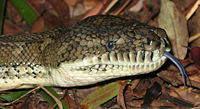
Photo from wikipedia
The vomeronasal organ is a poorly understood accessory olfactory organ, present in many tetrapods. In mammals, amphibians and lepidosaurian reptiles, it is an encapsulated structure with a central, fluid-filled lumen.… Click to show full abstract
The vomeronasal organ is a poorly understood accessory olfactory organ, present in many tetrapods. In mammals, amphibians and lepidosaurian reptiles, it is an encapsulated structure with a central, fluid-filled lumen. The morphology of the lubricatory system of the vomeronasal organ (the source of this fluid) varies among classes, being either intrinsic (mammalian and caecilian amphibian vomeronasal glands) or extrinsic (anuran and urodele nasal glands). In the few squamate reptiles thus far examined, there are no submucosal vomeronasal glands. In this study, we examined the vomeronasal organs of several species of Australian squamates using histological, histochemical and ultrastructural techniques, with the goal of determining the morphology of the lubricatory system in the vomeronasal organ. Histochemically, the fluid within the vomeronasal organ of all squamates is mucoserous, though it is uncertain whether mucous and serous constituents constitute separate components. The vomeronasal organ produces few secretory granules intrinsically, implying an extrinsic source for the luminal fluid. Of three possible candidates, the Harderian gland is the most likely extrinsic source of this secretion.
Journal Title: Journal of Biosciences
Year Published: 2018
Link to full text (if available)
Share on Social Media: Sign Up to like & get
recommendations!